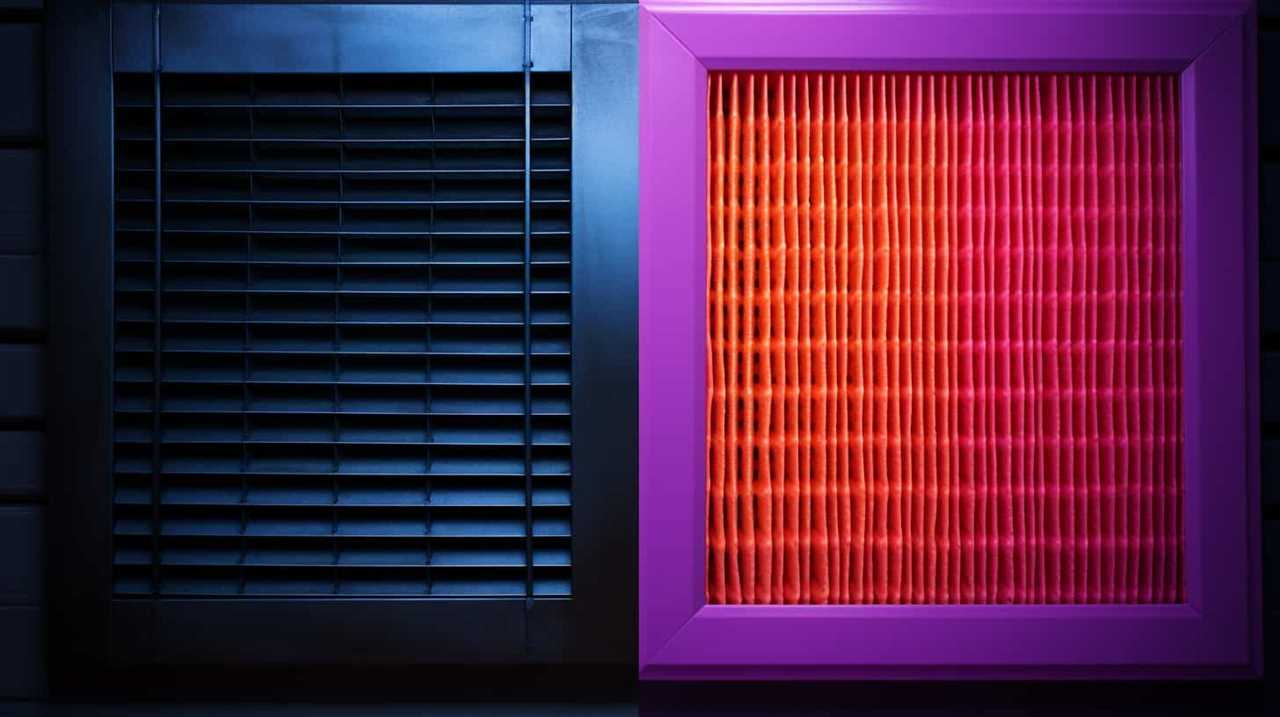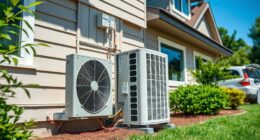Did you realize that we typically spend around 90% of our time indoors? This is why it is essential to make the quality of the air we breathe in our homes a top priority. Inadequate indoor air quality can harm our health, leading to respiratory issues and potentially severe conditions such as cancer and respiratory diseases. Thankfully, there are measures we can implement to enhance indoor air quality and establish a healthier living space.
Key Takeaways:
- Indoor air quality is essential for our overall well-being.
- Poor indoor air quality can lead to various health issues.
- Filtering the air, introducing fresh air, and managing humidity are key for improving indoor air quality.
- Removing sources of air pollution and controlling allergens are important steps.
- Using air purifiers and avoiding harmful chemicals further enhance indoor air quality.
Remove Sources of Air Pollution
One of the first steps in improving indoor air quality is to identify and remove sources of air pollution in your home. Many common household items can release harmful pollutants into the air, impacting the quality of the air you breathe.
Cleaning Supplies: Many cleaning products contain chemicals and volatile organic compounds (VOCs) that can contribute to poor indoor air quality. Look for eco-friendly and non-toxic cleaning alternatives, or consider making your own cleaning solutions using natural ingredients.
Paint and Chemicals: Paints, solvents, and other chemicals used for home improvement projects can release harmful fumes and VOCs. If possible, choose low-VOC or VOC-free options, and make sure to properly ventilate the area during and after painting or other projects.
Table: Common Sources of Air Pollution
| Source | Potential Air Pollutants |
|---|---|
| Cleaning Supplies | VOCs, ammonia, bleach |
| Paint and Chemicals | VOCs, formaldehyde |
| Furniture and Upholstery | Flame retardants, formaldehyde |
| Carpets and Flooring | Formaldehyde, VOCs |
| Plastics and Synthetic materials | Phthalates, VOCs |
Furniture and Upholstery: Some furniture and upholstery materials, particularly those treated with flame retardants, can release harmful chemicals into the air. Look for furniture made with natural materials or that are certified as low in volatile organic compounds (VOCs).
Carpets and Flooring: Carpets and certain types of flooring can emit volatile organic compounds (VOCs) and other pollutants. Opt for low-VOC or natural flooring options, and make sure to regularly vacuum or clean carpets to prevent the buildup of dust and allergens.

Improving indoor air quality is a collaborative effort. By removing sources of air pollution, we can create a healthier and safer environment for ourselves and our loved ones. Let’s take the necessary steps to eliminate these sources and breathe easier in our homes.
Next, we will discuss the importance of improving ventilation to enhance indoor air quality.
Improve Ventilation
Good ventilation plays a vital role in enhancing indoor air quality. It helps to circulate fresh air and remove stale air, reducing the concentration of pollutants and maintaining a healthier environment. There are various ways to improve ventilation in your home:
- Open windows and doors: Allowing fresh air to enter your home by opening windows and doors can significantly improve air circulation. This helps to remove indoor pollutants and bring in clean, outdoor air.
- Use exhaust fans: Running exhaust fans in areas with high humidity, such as the bathroom and kitchen, can effectively remove excess moisture and prevent the growth of mold. It also helps to expel odors and pollutants from these spaces.
- Install ventilation systems: Consider installing mechanical ventilation systems, such as whole-house fans or heat recovery ventilators (HRVs), to ensure a continuous supply of fresh air. These systems help to exchange indoor and outdoor air, improving air quality throughout your home.
By improving ventilation, you can create a healthier and more comfortable living environment. Adequate air circulation helps to reduce the concentration of indoor pollutants, control moisture levels, and enhance overall indoor air quality.

Enhancing Indoor Air Quality with Humidity Control
In addition to improving air circulation, controlling indoor humidity is also crucial for maintaining good indoor air quality. High humidity levels can promote the growth of mold and mildew, which can cause respiratory issues and allergies. On the other hand, low humidity can lead to dryness and discomfort.
Using humidifiers and dehumidifiers can help regulate humidity levels in different seasons. In humid climates, dehumidifiers can remove excess moisture from the air, while humidifiers add moisture to dry air in arid regions or during winter months.
Monitoring and maintaining an ideal indoor humidity level between 30-50% can prevent the growth of mold, improve respiratory comfort, and promote better overall indoor air quality.
Use Air Purifiers
Air purifiers are a valuable tool in improving indoor air quality. They are equipped with high-efficiency particulate air (HEPA) filters that can effectively remove airborne particles and pollutants from your home. These filters are designed to capture more than 99% of harmful particles, such as pollen, dust mites, pet dander, and even bacteria and viruses.
By using air purifiers, you can significantly reduce the presence of allergens in your home, which is especially beneficial for those with allergies or asthma. The filtration process helps create a cleaner and healthier environment for you and your family, promoting better respiratory health and overall well-being.
When choosing an air purifier, consider the size of the room and the CADR (clean air delivery rate) of the device. The CADR indicates the volume of clean air produced by the purifier per minute and can help you select the appropriate model for your space. Additionally, some air purifiers offer additional features like activated carbon filters to remove odors and chemical pollutants.
Remember, air purifiers are not a substitute for proper ventilation and regular cleaning practices, but they can be a valuable addition to your efforts in improving indoor air quality.
Table: Comparison of Top Air Purifiers
| Brand | Model | CADR (cfm) | Filtration System | Noise Level (dB) |
|---|---|---|---|---|
| Brand A | Model X | 350 | HEPA + Activated Carbon | 35 |
| Brand B | Model Y | 250 | HEPA | 40 |
| Brand C | Model Z | 400 | HEPA + UV-C | 32 |
Table: Comparison of top air purifiers, showcasing their CADR (clean air delivery rate), filtration systems, and noise levels. Please note that these values are approximate and may vary depending on specific models and configurations.
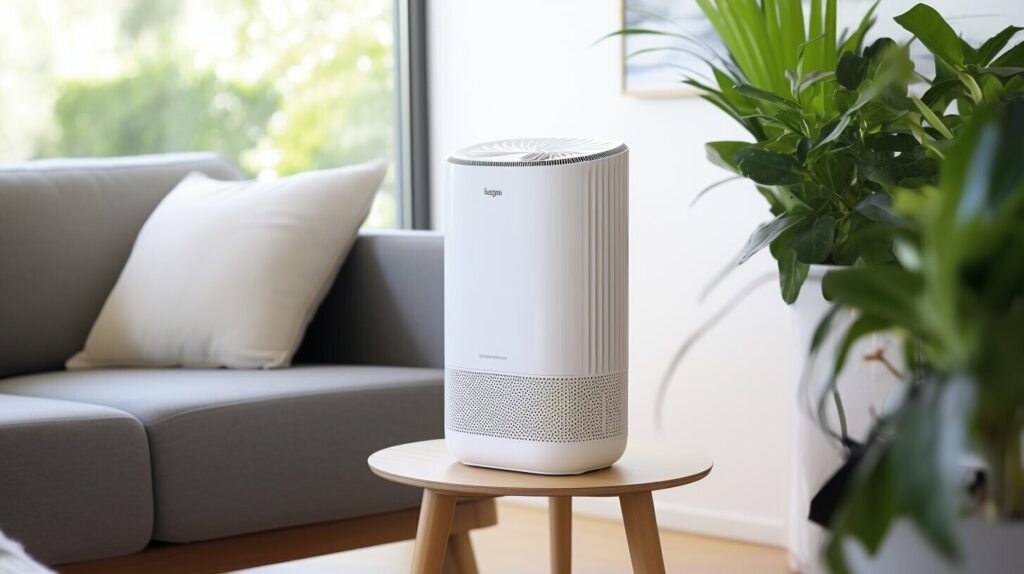
Control Allergens
Allergens such as dust, pet dander, and mold can have a negative impact on indoor air quality. To improve the air you breathe and reduce allergen exposure in your home, here are some effective strategies:
- Clean regularly: Dusting and vacuuming your home on a regular basis can help remove dust and pet dander. Use a vacuum cleaner with a high-efficiency particulate air (HEPA) filter for optimal results.
- Wash bedding: Wash your bedding, including sheets, pillowcases, and blankets, in hot water at least once a week to eliminate dust mites and other allergens.
- Bathe pets: Regularly bathing your pets can help reduce the amount of pet dander in your home. This is particularly important if you or any family members have allergies.
- Use hypoallergenic products: Opt for hypoallergenic pillows and mattresses to minimize allergen exposure while you sleep. These products are designed to repel dust mites and other allergens.
- Control moisture: Keep your home dry and free from excessive moisture to prevent mold growth. Use a dehumidifier in areas prone to dampness, such as basements and bathrooms.
By implementing these measures, you can effectively control allergens in your home and improve the overall air quality. Remember, good indoor air quality is essential for a healthy and comfortable living environment.
Allergen Control: A Case Study
“After implementing these allergen control strategies in our home, we noticed a significant improvement in our indoor air quality. My wife, who suffers from allergies, experienced fewer symptoms and could breathe more easily. Our home feels fresher and cleaner, and we have peace of mind knowing that we are taking proactive steps to reduce allergen exposure. It’s amazing how such simple changes can make a big difference in our overall well-being.”
By following these tips and making a few changes to your daily routine, you can create a healthier and more comfortable living space for you and your family. Taking control of allergen exposure is a crucial step towards improving indoor air quality.

Avoid Harmful Chemicals
When it comes to improving indoor air quality, it is important to be aware of the harmful chemicals that can be found in many household products. Volatile organic compounds (VOCs) are common culprits that can contribute to poor air quality. These chemicals are often found in air fresheners, cleaning products, and other household items.
To create a healthier home environment, it is recommended to avoid using products that contain VOCs whenever possible. Instead, opt for safer, nontoxic alternatives that are labeled as VOC-free. By making this simple switch, you can significantly reduce the amount of harmful chemicals released into the air in your home.
| Common Household Products Containing VOCs |
|---|
| Air fresheners |
| Cleaning sprays |
| Paints and varnishes |
| Adhesives |
| Carpeting and flooring |
In addition to avoiding products with VOCs, it is also important to properly ventilate your home when using any chemical-based products. Open windows and use exhaust fans to help remove any airborne pollutants and maintain good air circulation. This simple step can make a big difference in the overall air quality of your home.
By being mindful of the chemicals you bring into your home and making conscious choices to avoid harmful VOCs, you can create a safer and healthier living environment for you and your family.
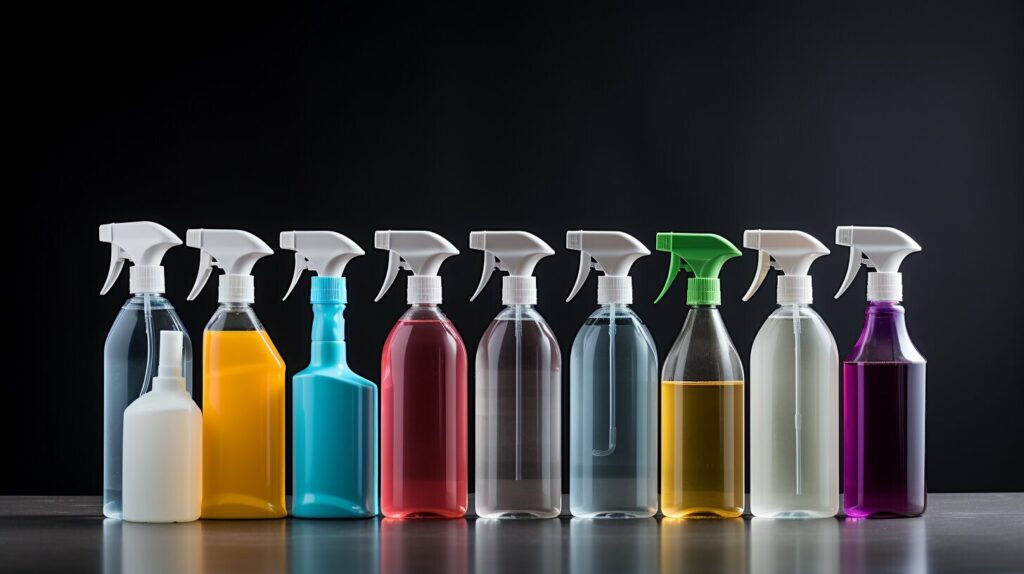
Maintain Clean Air Ducts
Air ducts play a crucial role in maintaining good indoor air quality by distributing heated or cooled air throughout your home. However, over time, dust, debris, and other pollutants can accumulate in the ducts, compromising the air flow and potentially releasing harmful particles into the air you breathe. To ensure that your indoor air quality remains high, it is important to regularly clean and maintain your air ducts.
Regular cleaning of air registers and grilles is a simple yet effective way to keep your air ducts in good condition. Dust and dirt can accumulate in these areas, obstructing the airflow and diminishing the overall efficiency of your HVAC system. By removing these obstructions, you can help maintain a healthier indoor environment.
For a more thorough cleaning, it is recommended to hire a professional air duct cleaning service. These experts have the necessary equipment and expertise to safely and effectively remove built-up dust, mold, and other contaminants from your air ducts. They use specialized tools and techniques to reach deep into the ducts and ensure a comprehensive cleaning.
By keeping your air ducts clean, you can prevent the circulation of dust, allergens, and other pollutants in your home, improving the overall indoor air quality and promoting a healthier living environment for you and your family.
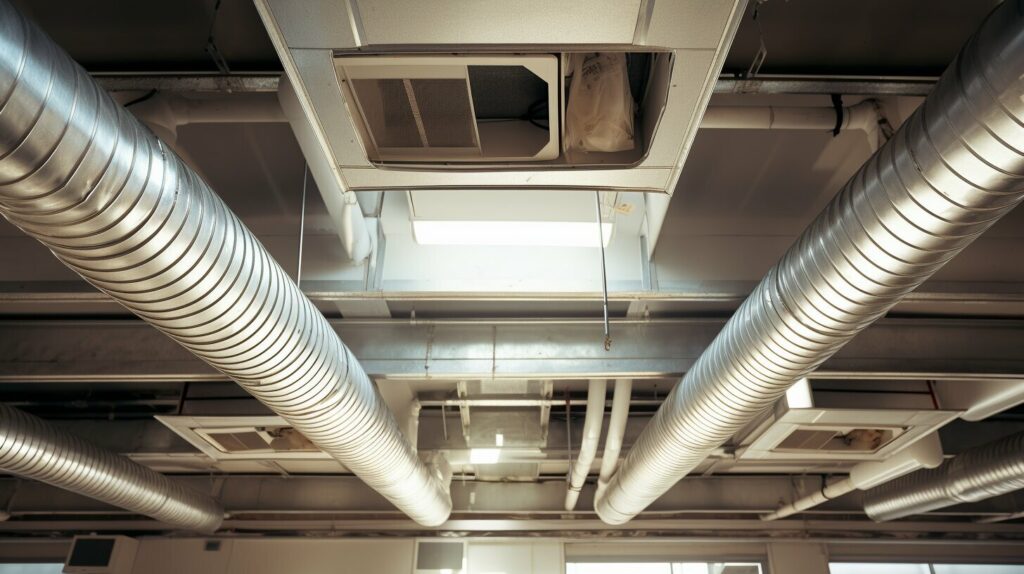
Conclusion
Improving indoor air quality is essential for creating a healthier and more comfortable living space. At Our Healthy Home, we understand that the air we breathe has a direct impact on our well-being. By implementing some simple strategies, you can significantly enhance the quality of the air in your home.
First and foremost, it’s crucial to remove sources of air pollution from your living space. By keeping cleaning supplies, chemicals, and other pollutants out of your main living area, you can greatly improve indoor air quality and reduce the risk of respiratory issues.
Another important aspect to consider is ventilation. Proper air circulation is key to maintaining a healthy home environment. Opening windows and doors to let fresh air in, using exhaust fans in bathrooms and kitchens, and managing indoor humidity levels can all contribute to better indoor air quality.
In addition to these measures, utilizing air purifiers with HEPA filters is highly recommended. These devices effectively filter out harmful particles and allergens, keeping the air in your home clean and fresh. Controlling common indoor allergens, like dust, pet dander, and mold, through regular cleaning and preventative measures, also plays a significant role in improving indoor air quality.
Lastly, it’s important to be mindful of the products we use in our homes. Avoiding harmful chemicals found in air fresheners, cleaning products, and other household items can greatly reduce indoor air pollution. Opting for nontoxic alternatives and proper ventilation when using VOC-containing products are simple yet effective ways to create a healthier indoor environment.
By implementing these strategies and maintaining clean air ducts, you can create a healthy home environment with improved indoor air quality. At Our Healthy Home, we believe that everyone deserves to breathe clean, fresh air, and we’re here to guide you on your journey towards achieving a healthier living space.
Can HVAC Systems Help Improve Indoor Air Quality?
Efficient hvac systems play a crucial role in enhancing indoor air quality. These systems filter pollutants, allergens, and pathogens, ensuring cleaner and healthier air. By properly ventilating and controlling humidity levels, efficient HVAC systems help prevent mold growth, reducing respiratory issues. Regular maintenance and filter replacements are essential to maximizing their efficiency and improving indoor air quality.
FAQ
What are some common sources of air pollution in my home?
Common sources of air pollution in your home can include cleaning supplies, paint, and other chemicals. Simply moving these items to a garage or storage area can help improve the air quality in your main living area.
How can I improve ventilation in my home?
Opening windows and doors to let fresh air in can be an effective way to improve air circulation. Running a bathroom or kitchen exhaust fan can also help remove stale, humid air from the home. Maintaining an ideal indoor humidity level of 30-50% is important for preventing the growth of mold and improving air quality.
Are air purifiers effective in improving indoor air quality?
Yes, air purifiers with high-efficiency particulate air (HEPA) filters are effective in removing airborne particles and allergens from the air. HEPA filters can capture more than 99% of harmful particles, such as pollen, dust mites, and pet dander. Using air purifiers can significantly improve indoor air quality and reduce the presence of allergens in your home.
How can I control common indoor allergens?
Regular cleaning, vacuuming, and dusting can help control common indoor allergens like dust, pet dander, and mold. Taking preventative measures like bathing pets regularly, washing bedding in hot water, and using hypoallergenic pillows and mattresses can also reduce allergen exposure and improve air quality.
What should I avoid to improve indoor air quality?
Many household products, such as air fresheners and cleaning sprays, contain harmful volatile organic compounds (VOCs) that can contribute to poor indoor air quality. Avoiding these products whenever possible and choosing safer, nontoxic alternatives can help improve indoor air quality. Thoroughly ventilating your home when using VOC-containing products is also recommended.
How can I maintain clean air ducts in my home?
Regularly cleaning and dusting air registers and grilles, as well as hiring a professional to clean your air ducts, can help improve indoor air quality. Dust and debris can accumulate in air ducts over time, reducing air flow and potentially releasing pollutants into your home.
Why is improving indoor air quality important?
Improving indoor air quality is essential for creating a healthier and more comfortable living space. By removing sources of air pollution, improving ventilation, using air purifiers, controlling allergens, avoiding harmful chemicals, and maintaining clean air ducts, you can significantly enhance the quality of the air you breathe indoors. Prioritizing indoor air quality is a key step towards creating a healthy home environment.

